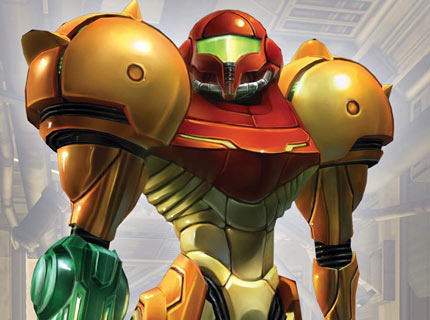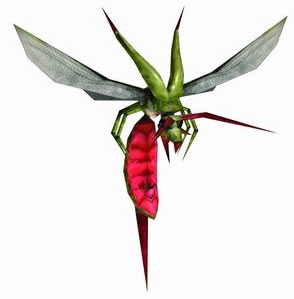Metroid Prime – Play Notes Overview #1
June 2nd, 2011
And now a quote from Twitter:
I’m thinking that by E3 I should be able to finish my first play through notes of Metroid Prime. Up to Magmoor Caverns now.
Yeah, I sure do like to dig holes for myself, don’t I?
Truth is I’m finding it much easier and more enjoyable plugging away at my Chinese blog at the moment than continuing on either one of these mammoth projects I’ve burdened myself with. I enjoyed writing up the Wario Land 4 posts, but the thought of whipping everything into perfection is an intimidating task to say the least. I’m thinking that I hold off on that for a little longer. On the other hand, writing about Metroid Prime is a passion project. Even as I take notes I’m so caught up by this game and long to study it further. The problem is I still haven’t found my hook for the project. A complete analysis would be a laborious task indeed and not exactly palatable for a general audience, so I need an engaging format that will hold the information of a text book while being immediately readable.
Format or no format, I need to hone my analysis, so here’s a summary of my key observations so far, from the Pirate Frigate through to Magmoor Caverns.
Foreshadowing
Samus and the player begin their adventure on a Space Pirate frigate. In typical Metroid fashion, you’ve walked into a situation that’s already happened and are left to piece together the remnants. The frigate serves not just as its own segregated tutorial level, but also foreshadows the rest of the game. By being observant from the start, the player is given a gist of what’s to come. Here are some examples:
Space Pirate’s plan – As the player explores the frigate they learn, through scanning the environment, that the space pirates have been using native fauna from the nearby Tallon IV as scientific test subjects for a hazardous substance known as phazon. The results of these experiments are in turn what has caused the disaster to occur and thus bring Samus to the frigate. The data scans reveal that the pirates are present on Tallon IV, continuing their research. Although only partly fleshed out through text and a few images, the outline for most of Metroid Prime’s narrative is established.
Enemies – The laboratories where the pirates have been conducting these experiments also house test-tubed creatures from Tallon IV. The player can walk up to and view models of the creatures who will later act as enemies of Tallon IV. Some of the staple enemies can be scanned as well, but only for temporary data. The lab acts as a sort of museum for pre-viewing. Meta Ridley also makes a presence in a cutscene which leads the player to the inevitable conclusion that they’ll have to once again beat Ridley at one point.
Abilities – On arriving at the frigate, Samus’ suit is equipped with all of her basic abilities which is then taught piece-by-piece before she loses it all at the end of the chapter. On Tallon IV the player slower reacquires all of the abilities that they had previously lost and more. This type of pre-teaching is important later when stringing the player along the game.
Parasite Queen – The Parasite Queen is the height of the experiments and is mostly responsible for the mayhem that had erupted onboard. Details about the queen are littered throughout the confines of the frigate in a sort of suspenseful horror fashion, the player slowly connects the dots before being confronted by the Queen. Unlike the other points the foreshadowing isn’t tied to Tallon IV, only in the introduction.
Technological Trickery and Gameplay
A lot of games parade different areas of technology, like facial masking, physics etc, for technology’s sake and not much else. Metroid Prime is a runway of neat effects that were pretty new and flashy at the time, but each piece of graphical trickery plays a significant part in the gameplay. Again, examples:
Light – Phasites are harmless little bugs which float around and emit light. They populate darkened rooms. If the player shoots and kills a Phasite then they’ve effectively killed a light source. The trick is that the player needs to use the flow of the Phasites to navigate through these darkened paths.
Dust – Scarabs burrow below ground and then leap out to attack any threats that they feel moving along the ground surface. As they dig to the surface, the ground rumbles and dust stirs up drawing the player’s attention to the threat. The dust effect is used to warn the player.
Obscuring of visor – Bug splatters, electrical zaps and fogging up of the visor all directly affect gameplay as the player only sees through the visor.
Enemy Distinctions
Metroid Prime has some fantastically detailed environments. This, however, can make it difficult to identify enemies. In order to be distinguishable amongst the detail many enemies are painted in tonally darker or less saturated colours marked with strong colours at their weak points. War Wasps have painted stingers. Turrets have bright red lights to show that they’re active. Eyons shoot green rays of light. When Shriek Bats dive at the player a whirl of colour surrounds them.
Ideologies
Scattered throughout the Chozo Ruins is the parallel narrative of the Chozo’s history told through the lore scans. By scanning scriptures marked on walls the player pieces in the story as they play. The first thread of scans sets up the Chozo as the civilisation side of Metroid Prime‘s underlying civilisation vs technology theme. Later, the Space Pirates occupy the technology side of the argument. The game begins with civilisation (Chozo Ruins) and then ends with technology (Phazon Mines).
First Person Dynamics and Enemies
Set in the first person perspective, Metroid Prime‘s core dynamic is positioning and searching the 3D space. 2 of the core mechanics in the game, look and lock-on, work harmoniously with the natural dynamic of the perspective, breaking the process of looking into 2 steps.
The lock-on is important because it maintains the position of the target, so that the player isn’t always frantically trying to find a target. This streamlines a lot of the hassles common in exploring other first person games, especially those for the PC. Anyways, I’ll get into this properly later, it’s all very interconnected.
My point is that the enemies are designed to get the player looking and locking-on or moving, looking and locking on. The wasps float around in the sky, the scarabs dig underground, the smaller swarm enemies circle the insides of tunnels, the larger enemies have weak points located away from the player—each enemy type is meant to get the player to look and lock-on in unique ways.
Environment as the Patriarch
The richest character in the game is the environment. What is key about the environment in Metroid Prime is the way in which it both facilitates and (contextually) justifies the challenges of the game while also sketches out a lore and ecosystem. The environment of Metroid does 10x the work of the environments in most other games, so just to unpack that a little bit…
The environment obviously facilitates play. It’s the way that the environment is used to justify everything that makes it so unique. Instead of throwing up clear road blocks to stop the player from advancing to a certain area (ie. you need to kill 20 of this to pass), Metroid Prime will use the environment and it’s connection to Samus’ abilities to limit progress in an organic and well justified way. For example, height, a poisoned water stream, an infestation of weeds or the pressure from heat will act as road blocks. In this way the logic of the game is very naturalistic. It never feels as though the developers are artificially constraining you, the player.
The lore and ecosystem of the land is fleshed out through the scan mechanic which is effectively an all-in-one narrative, hint and activation mechanic. What you can scan is in the environment, so the environment is the narrator of Metroid Prime‘s story. Reading this story requires looking through the space and engaging with the natural dynamics of the perspective. And so the circle of harmonisation is complete.
And further on organic environments
I really dig how the topography of the environment isn’t broken into units or boxes, or at least it doesn’t feel that way to the player. The rooms take on a variety of rugged shapes. The floor dips and raises. It’s all very organic. To think that Metal Gear Solid 3 struggled with creating such organic environments, limiting it’s FPS count to just 30fps even after the PS2 tech was well understood by developenv and Metroid Prime does it so effortlessly.
Slow Down
The first part of the Metroid Prime is designed to slow players down. The focus is placed on Samus’ eyes and not her legs. That is, the game coaxes the player into being explorers. Blast Caps are placed on platforms prompting players to shoot first, wait for their dangerous smog to clear and then jump. War Wasps get in the player’s face intentionally, so as to get the player to seek out and destroy their nests. Shriek Bats can easily spear into players if they move through rooms too hastily—the best approach is to move cautiously and attack them while they’re in wait. Runes are used as locks to doors and are spread throughout a single room to get the player scanning the environment in all different directions. All elements of Metroid Prime, the tight spacing of most rooms, enemies and scannable items all enforce this more cautious type of play.
And that’s a wrap for this first overview. I feel like I’ve only scratched the surface with each of these headings. If you have any suggestions for a hook for this project, please let me know in the comments below.





 Game Design Companion: A Critical Analysis of Wario Land 4 - $7.99
Game Design Companion: A Critical Analysis of Wario Land 4 - $7.99 Level Design: Processes and Experiences
Level Design: Processes and Experiences Speed Boost: The Hidden Secrets Behind Arcade Racing Design - $5.99
Speed Boost: The Hidden Secrets Behind Arcade Racing Design - $5.99 Adventures in Games Analysis: Volume I - $5.99
Adventures in Games Analysis: Volume I - $5.99







